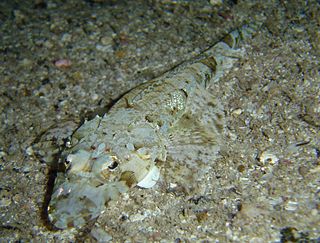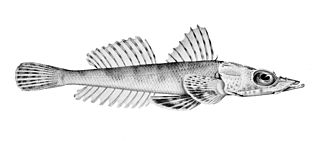
Platycephalus is a genus of mostly marine, demersal ray-finned fish belonging to the family Platycephalidae. They are found in the eastern Mediterranean, the Indian Ocean and western Pacific Ocean.

The tentacled flathead, also known as the Indian Ocean crocodilefish, Madagascar flathead or longhead flathead, is a species of marine ray-finned fish belonging to the family Platycephalidae, the flatheads. This species is in the western Indian Ocean, including the Red Sea and the Mediterranean, having invaded as a Lessepsian migrant through the Suez Canal. It is the only species in the monotypic genus Papilloculiceps.

The bartail flathead, also known as the Indian flathead, gobi or Indo-Pacific flathead, is a species of largely marine ray-finned fish belonging to the family Platycephalidae, the flatheads. This species is found in the Indian Ocean and the Western Pacific Ocean, and has invaded the eastern Mediterranean Sea.

Platycephalus speculator, the southern bluespotted flathead, Castelnau's flathead, deepwater flathead, king flathead, Lakes Entrance flathead, longnose flathead, shovelnose flathead, Southern dusky flathead, Southern flathead or yank flathead, is a common species of flathead. This species is endemic to southern Australia.

Platycephaloidei is a suborder of ray-finned fishes, part of the order Scorpaeniformes, and includes the flatheads, ghost flatheads and sea robins.

Hoplichthys, the ghost flatheads, is a genus of marine ray-finned fishes native to the Indian and Pacific Oceans. This genus is the only member of the family Hoplichthyidae.

The mud flathead is a species of flathead endemic to the Pacific coastal waters of Australia where it occurs at depths of from 15 to 53 metres on the continental shelf. This species is the only known member of its genus.

Cymbacephalus is a genus of marine ray-finned fishes belonging to the family Platycephalidae, the flatheads. These fishes are found in the Indo-Pacific region.

The dwarf flathead is a species of marine ray-finned fish belonging to the family Platycephalidae, the flatheads. It is found in the Indo-Pacific. It is the only species in the monotypic genus Elates.
The spiny flathead, also known as the whitefin flathead or Bengal flathead, is a species of marine ray-finned fish belonging to the family Platycephalidae, the flatheads. It is found in the Indo-West Pacific region. This species is the only known member of its genus.

The Longhead flathead, also known as the crocodile flathead or weed flathead, is a species of marine ray-finned fish belonging to the family Platycephalidae, the flatheads. This species is endemic to reefs in the coastal waters of southern Australia.

Rogadius is a genus of marine, demersal ray-finned fish belonging to the family Platycephalidae. These fishes are native to the Indian Ocean and the western Pacific Ocean.

Thysanophrys is a genus of marine, demersal ray-finned fish belonging to the family Platycephalidae. These fishes are native to the Indian Ocean and the western Pacific Ocean.

Platycephalus laevigatus, the rock flathead, black flathead, grass flathead, king flathead, marbled-bellied flathead, Port Albert flathead, smooth flathead or Southern rock flathead, is a species of marine ray-finned fish belonging to the family Platycephalidae, the flatheads. This species is endemic to Australia.
Platycephalus endrachtensis, or the bar-tailed flathead, bar-tail flathead, flag-tail flathead, northern sand flathead, northern-flag tailed flathead, sand flathead, western estuary flathead, is a predatory fish in the family Platycephalidae. It is found from the eastern Indian Ocean to the western Pacific, including in Australian and Indonesian waters up to 60 m (200 ft) deep over sand, at temperatures between 17 and 18 °C. The maximum length of the species is 62 cm (24 in), and its weight up to 5 kg (11 lb). A popular angling species, the specific epithet endrachtensis refers to Eendrachtsland, an early Dutch name for Australia, with the suffix -ensis, meaning "place". Venomous spines are hazardous for safe handling.
Cociella somaliensis is a species of demersal, marine ray-finned fish belonging to the family Platycephalidae, the flatheads. It is found in the north western Indian Ocean.
Inegocia japonica, the Japanese flathead, rusty flathead or smooth flathead, is a species of marine ray-finned fish belonging to the family Platycephalidae, the flatheads. It is found in the Indo-West Pacific region.
The semi-armed flathead is a species of marine ray-finned fish belonging to the family Platycephalidae, the flatheads. This species is endemic to the coastal waters of southern Australia. It was confirmed as a valid species in 2020.

The halfspined flathead is a species of marine ray-finned fish belonging to the family Platycephalidae, the flatheads. This species is found in the western Indian Ocean and the Red Sea.

The tuberculated flathead is a species of marine ray-finned fish belonging to the family Platycephalidae, the flatheads. This species is found in Indian and Western Pacific Oceans.















